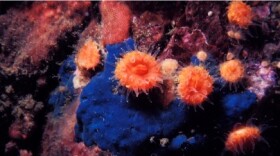Washington Gov. Jay Inslee said he was stunned to see how much water hit communities in Whatcom County and how fast it came in. That’s after he toured sites in Everson, Sumas and Ferndale on Wednesday.
He said the swollen Nooksack River caused significant damage to about 500 homes that area and forced hundreds to flee their homes and businesses.
It was important for him to be there to really understand the magnitude and speed of the flooding, he explained.
“People were in the middle of a river that was a berry field the day before. And until you really see that, you don't understand how devastating this flood can be,” Inslee said. “And that's why all of us are going to have to band together to figure out how to make these communities more resilient.”
He said that means using money from the federal infrastructure bill to rebuild roads and sewer systems with this kind of flooding in mind. And it means the state transportation package that’s coming up for negotiation will need to account for climate-driven disaster scenarios.
He also urged families and businesses that are impacted by this week’s high water to document their losses and submit those estimates to their mayors. The state will compile a total and seek emergency aid from the federal government.
While he spoke to the media Wednesday, Inslee emphasized that the heavy rains and subsequent flooding are part of a pattern that he called “a permanent state of attack by the forces of climate change.”
He said it was evident this summer with the devastating heat dome that killed dozens of people, the drought in eastern Washington and massive forest fires in the Methow Valley.
“And we have to realize that we're going to face decades of increased floods in our state of Washington. This is one flood of unfortunately many that we will be experiencing,” Inslee said. “And all of us are going to have to band together to become as resilient as possible facing the increased flood threats that we will be facing.”
Inslee said the state is not meeting its goals for carbon reduction and that he will ask the Legislature in the next session to take further steps to that end.
“We've had some success in Washington state, but we need to have more," he said.
More rain fell in Bellingham from Saturday through Monday — about 5.57 inches — than normally falls there during all of November, according to National Weather Service data. The normal monthly rain total is 5.2 inches for November, the agency said.
Meanwhile, cleanup is underway in the hardest hit areas.
Sumas city officials said Thursday that volunteers had begun going door-to-door to determine which homes were damaged.
Laura Anker, store manager of Cherry Street Market in Sumas, said Thursday that they were in full clean-up mode.
“It's not great, but we're hanging in there,” she said.
The Red Cross said it is operating three shelters north of Seattle to support residents displaced by flooding. Inslee said short-term shelter and housing options are being investigated for people in Whatcom County as well as cash assistance.
In British Columbia, the federal government was sending in the military to help with floods and mudslides that destroyed parts of several major highways. Vancouver, B.C., was cut off by road from the interior of the province.
The mayor of Abbotsford, B.C., said he would speak with Inslee to discuss severe flooding on the Canadian side of the border at least partially caused by swollen rivers in the United States.
Transportation officials on Washington’s Olympic Peninsula were also assessing conditions and clearing debris from roads as state agencies, including the military, worked to bring fuel to the Makah Tribe, which was cut off by damaged roads, and drinking water to residents in the Clallam Bay and Sekiu areas.
A landslide several days ago caused a water main to break, and the Clallam Bay water reserve was nearly depleted by Wednesday night, officials said.
The Associated Press contributed to this report.







